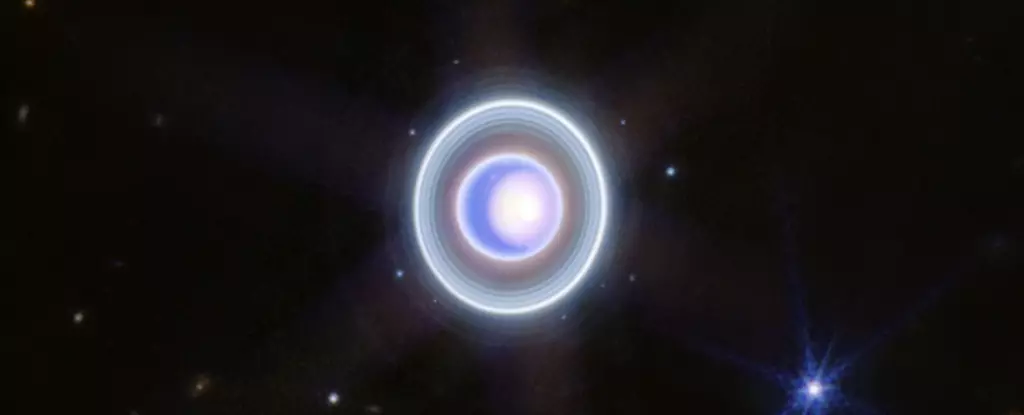For many years, scientists believed that the planet Uranus, the seventh from the Sun, was largely understood within the framework established by the Voyager 2 flyby in 1986. However, recent analyses challenge the accuracy of our longstanding perceptions regarding Uranus’s magnetic field and overall characteristics, suggesting that what we know is largely colored by transient solar phenomena. This newly scrutinized perspective has profound implications for our understanding of Uranus and its place within our Solar System.
Voyager 2 has been hailed as a significant milestone in planetary exploration. During its historic pass through the Uranian system, it provided invaluable data about the planet and its magnetosphere. Unfortunately, its observations depicted Uranus in an unusual and perplexing light—one where the magnetosphere appeared irregular, misaligned, and markedly distinct from those of other gas giants like Jupiter and Saturn. For decades, this imagery informed the scientific community’s understanding of Uranus, suggesting a highly dynamic and chaotic magnetic environment.
However, Jamie Jasinski, a space plasma physicist at NASA’s Jet Propulsion Laboratory, posits that these observations might not represent the norm. His team’s recent research points to the possibility that Voyager 2’s measurements were captured during an anomalous juncture of heightened solar activity that distorted the magnetic environment around Uranus. This revelation begs the question: How much of our understanding of Uranus has been built upon this possibly erroneous foundation?
Upon reviewing the data collected before the Voyager 2 flyby, Jasinski and his team found a significant increase in solar wind pressure—up to 20 times higher than normal—just before the spacecraft’s arrival. This spike in solar activity likely compressed Uranus’s magnetosphere to just a fraction of its usual size, resulting in a misleading portrayal of its magnetic dynamics. The revelation indicates that disturbances from solar winds may have created a scenario where the observed conditions were exceptional rather than typical.
Such insights shed light on the inherent variability of space weather and reinforce the notion that the Solar System is an active and dynamic environment. It highlights the need for continuous observation over extended periods to accurately capture the behavior of planetary atmospheres and magnetic fields. Without a doubt, more extensive studies are necessary to contextualize past observations and draw reliable conclusions about Uranus’s characteristics.
The implications of this new perspective are far-reaching. Prior to Jasinski’s analysis, scientists had developed theories suggesting that the interior of Uranus, where its magnetic field is generated, was unique among its gas giant counterparts. However, if the abnormal measurements from Voyager 2 can be attributed to a short-lived solar event, reevaluating these theories becomes imperative. Researchers may need to consider alternative models of Uranus’s interior and magnetic field generation mechanisms.
Understanding the nature of Uranus’s magnetosphere in a more consistent context raises pertinent questions about its overall environment. For instance, if measurements were consistently observable under standard conditions, could Uranus’s magnetic field align more closely with that of other gas giants? This perspective could radically reshape our understanding of the planet’s physical properties and behavior.
The findings by Jasinski and his team reinforce the urgent need for additional missions to Uranus and its sibling planet, Neptune. Voyager 2’s fleeting visit provided only a snapshot, not an exhaustive examination of Uranus’s complex system. With ongoing advancements in space exploration technologies, a dedicated mission to study these distant worlds could yield breakthroughs, leading to an enriched understanding of their volatile atmospheres, magnetic environments, and possibly revealing interactions with their moons.
Uranus is a treasure trove of mysteries still waiting to be unraveled. The unique factors influencing its magnetosphere and exploration history suggest that previous assumptions may need to be rewritten. The realization that we might have observed Uranus under distorted conditions underscores the dynamic nature of these breathtaking orbital bodies.
As scientists continue to dissect historical data and develop new theories about Uranus, the discoveries made by Jasinski’s team remind us of the importance of questioning the established narrative. The mysteries surrounding Uranus serve as a testament to the complexity of the cosmos and the need for persistent inquiry. As we venture further into our Solar System, it is crucial to remain open to the unexpected, recognizing that our understanding today may merely scratch the surface of a far more intricate and fascinating reality. Uranus continues to be a unique puzzle, and future missions may hold the keys to unlocking its mysteries.


Leave a Reply